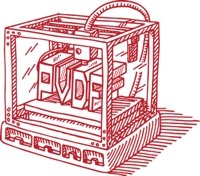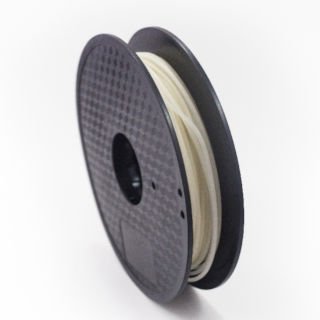
POLY (VINYLIDENE FLUORIDE)
Known as fused deposition molding (FDM), fused filament fabrication (FFF) or 3D printing this additive manufacturing method creates plastic parts at the point of use. Using either poly lactic acid (PLA) or acrylonitrile butadiene styrene (ABS) filaments, 3D printing is transforming many manufacturing segments. But not the chemical process industry. Consumer-grade 3D filaments lack property requirements such as high-purity manufacturing, material traceability, chemical resistance, non-flammability and low extractables. With Kynar® filament PLA and ABS aren’t even in the game.
Fluorinar-H™ Kynar® filament changes everything.
Nile Polymers was the first to manufacture and sell a 3D print filament made from Arkema’s Kynar® PVDF. Known as Fluorinar-H™, this PVDF homopolymer filament is available in 500 g spools with either a 1.75 mm or 2.85 mm diameter with a +/- 0.05 mm tolerance. Now scientists and engineers can design and manufacture parts required in the lab or in production without the time and expense needed to create an injection molded part. This filament is ideal for either rapid prototyping or for small production runs. PVDF parts can be created from Fluorinar-H™ PVDF filament in a matter of hours instead of months.
FLUORINAR-H™ PVDF PRINT SETTINGS

| Print Temp Range | 250 – 260 C |
| Bed Temp Range | 100 C |
| Cooling Fan | No |
| Print Speed Range | 10 – 30 mm/s |
| Bed Adhesion | Print objects on glass bed that is prepared with a thin layer of Elmer’s Disappearing Purple Glue Stick |
Additional information about Fluorinar-H™ PVDF filament and PVDF in general can be found on the following pages:
Fluorinar-H™ Technical Data Sheet (TDS)
Fluorinar-H™ Safety Data Sheet (SDS)
Fluorinar™ Chemical Resistance Chart
PVDF Filament for Industrial 3D Printing
Successful Prints with Fluorinar™ PVDF Filaments
![]() Rapid prototype development
Rapid prototype development
![]() Small quantity part production
Small quantity part production
![]() CNC machining of 3D printed solid stock for tight tolerance requirements
CNC machining of 3D printed solid stock for tight tolerance requirements
![]() Optimal print results can be achieved on all consumer-grade printers
Optimal print results can be achieved on all consumer-grade printers
![]() Filament traceability by production lot number
Filament traceability by production lot number
![]() No off-gassing during 3D printing due to PVDF melt stability
No off-gassing during 3D printing due to PVDF melt stability
![]() Corrosion resistant 3D prints
Corrosion resistant 3D prints
![]() No loss of mechanical strength after long-term UV exposure
No loss of mechanical strength after long-term UV exposure
![]() Extractables measured by ICP-MS at ppb level
Extractables measured by ICP-MS at ppb level




